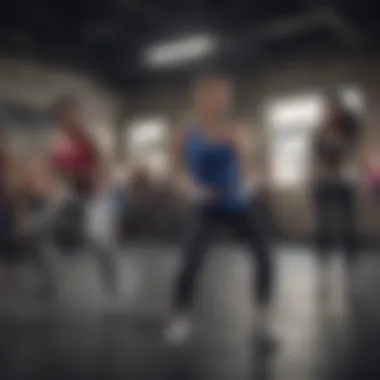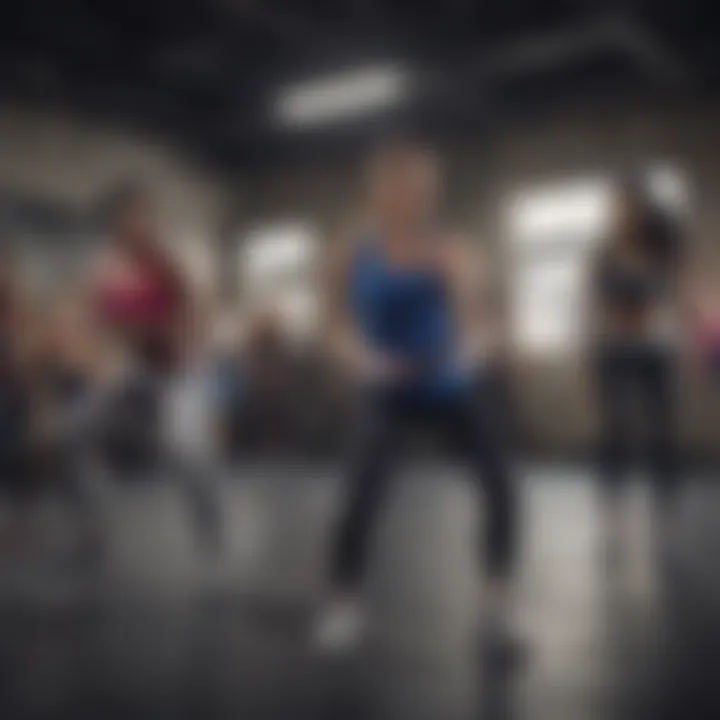Hip Hop Workout Guide for Beginners: Get Fit to the Beat


Intro
In recent years, hip hop has transcended the boundaries of music to become a compelling avenue for physical fitness. Combining infectious rhythms with energetic movements, hip hop workouts are perfect for beginners looking to merge fun and fitness. The beauty of this style lies not merely in the sweat it induces but in the cultural heartbeat it represents. This guide aims to explore how hip hop can serve as a vibrant backdrop to fitness, helping newcomers to create personalized plans that resonate with their fitness goals while enjoying the rhythmic flow that hip hop brings.
Benefits of Hip Hop Workouts
Engaging in hip hop workouts is not just about physical exertion; it's also about embracing a rich culture and community. The benefits can be plenty:
- Increased Cardiovascular Health: The fast-paced nature of hip hop dance boosts heart rate, which is crucial for maintaining cardiovascular fitness.
- Improved Coordination and Balance: The diverse movements enhance motor skills, making it easier to perform daily activities with grace.
- Boost in Mood and Confidence: The upbeat vibes of hip hop can elevate one's mood, making workouts feel less like chores and more like celebrations.
- Cultivation of Self-Expression: Through dance, individuals can express their creativity and emotions, allowing for a deeper connection to their workout.
Hip hop workouts tap into the essence of dance as a medium for expression. When you move to the rhythm, it’s not just about following steps; it’s about feeling the beat and letting it guide you through an empowering physical journey.
The Basics for Beginners
For those stepping into this world for the first time, some essential aspects to consider include:
- Finding Your Style: Hip hop encompasses various styles—breaking, locking, popping, and more. Explore them to find which resonates with you.
- Starting Slow: Begin with basic moves to build confidence. Over time, as you feel more comfortable, you can introduce more complex steps.
- Set Realistic Goals: Establish achievable milestones, whether it's mastering a particular move or increasing workout duration.
- Join a Community: Look for local classes or online forums. Engaging with others who share your interest can provide motivation and support.
"The beauty of hip hop lies not just in the moves, but in the community and culture it fosters. It's a journey—enjoy the ride!"
As we explore the various aspects of integrating hip hop into workout routines, remember that the rhythm is yours to discover and make your own.
Understanding the Hip Hop Culture
Understanding hip hop culture is like peeling back the layers of an onion; there are many complexities that contribute to its richness and influence. This culture is not just a form of music; it’s a movement that combines artistic expression, social commentary, and physical activity. For anyone venturing into hip hop workouts, grasping the essence of this culture can enhance your connection to the music and improve your overall experience. The rhythm, the beats, and the street credibility all play a role in how we move, dance, and feel motivated.
Historical Context
Hip hop originated in the 1970s in the South Bronx, emerging as a response to the socio-economic challenges faced by marginalized communities. It sprouted from block parties, where DJing and rapping became popular pastimes. The historical context of hip hop cannot be underestimated, as it reflects a struggle for identity and expression. Understanding where hip hop came from leads to a deeper appreciation of its evolution into a global phenomenon that has transcended barriers. It has not only influenced music but also fashion, language, and art, shaping entire lifestyles.
Elements of Hip Hop
Hip hop comprises several elements that together create its distinctive identity: rap, DJing, B-boying, and graffiti. Each of these aspects contributes to the culture differently, but they all support its soul.
Rap
Rap serves as a powerful storytelling medium. It’s characterized by rhythm and rhyme, allowing artists to convey their thoughts and emotions. The punchy lyrics often reflect the struggles and triumphs of life, making them relatable to many. This synergetic relationship between words and music paves the way for an engaging atmosphere in workouts. Utilizing rap in your exercise routine not only keeps you motivated but can also stimulate mental engagement, making it more enjoyable.
DJing
DJing is another critical part of hip hop. DJs don’t just play music; they create an experience that gets people moving. The ability of a DJ to mix tracks on the fly ensures a continuous flow of energy. In the context of a workout, the right DJ can elevate a typical session into an unforgettable event, keeping the vibe alive and participants energized. The unique skill of beatmatching and blending songs enhances the overall tempo and mood of the workout.
B-boying
B-boying, or breakdancing, brings an energy that can’t be ignored. It’s a physical expression of the beats in hip hop music, showcasing athleticism and creativity. Learning B-boying techniques can significantly enhance physical fitness; the strength and agility required challenge the body in an entertaining way. It not only emphasizes coordination but can also be adapted for various skill levels—a useful aspect for beginners looking to break into the scene.
Graffiti
Graffiti, while often overlooked in a fitness context, serves as a visual representation of hip hop culture. It tells stories and communicates messages. The aesthetics can inspire creativity in your workouts, setting a funky atmosphere that invites self-expression. Although it might not be a physical activity like the others, embracing the spirit of graffiti can lead to a more holistic connection to hip hop culture.
"Understanding hip hop is not about mastering its elements; it’s about feeling the pulse of its community and letting that rhythm guide your journey."
Learning to incorporate these elements into your workouts goes beyond just exercise; it becomes a way to express oneself and connect with a vibrant culture. Diving into hip hop isn’t merely about adopting a new workout; it’s an invitation to be part of something greater, allowing you to celebrate both your fitness journey and the rich tapestry of hip hop.
The Connection Between Hip Hop and Fitness
The fusion of hip hop and fitness isn’t just a trend; it’s a movement that has captured the hearts (and bodies) of many. Hip hop culture, with its thumping beats and vibrant expressions, provides a backdrop that brings physical activity to life. This connection is not only about dancing; it's about expressing oneself while getting fit. The heart of this connection lies in how the rhythm energizes movements and promotes a playful approach to exercise.
Rhythm and Movement
Rhythm is the core of hip hop, and it translates seamlessly into fitness. When beats drop, bodies respond instinctively. Imagine stepping onto the floor, feeling that bass thrum, and letting loose. It’s both liberating and invigorating. In a hip hop workout, each move is choreographed to coincide with the music, making every session feel not like an obligation, but like a celebration.
The connection here is deeply psychological as well. When individuals engage their minds with the beats and flows, it becomes easier to push through fatigue. Instead of counting reps or seconds, they could be counting beats. The joy of syncopated movement can lead to a healthier mindset towards exercise, making it more accessible and enjoyable for everyone, especially beginners.
Benefits of Dance Workouts
Dancing in a hip hop style isn't just enjoyable; it packs a punch in health benefits.
Cardiovascular Health
Focusing on cardiovascular health within hip hop workouts can lead to significant improvements in one's overall fitness. When you engage in these rhythmic movements, the heart starts to pump faster, and the lungs begin to work harder. This boost in your heart rate aids in increasing stamina over time.
One key characteristic of cardiovascular elements in hip hop workouts is their high energy, which can lead to burning calories efficiently. The non-stop motion, combined with powerful beats, ensures that individuals get a solid aerobic workout while soaking in the enjoyment of dancing.
The unique charm here is in how cardiovascular fitness can be achieved without the monotony often associated with traditional cardio workouts. No more staring at a wall on a treadmill; instead, you're navigating a flow of choreography that sparks joy.
Flexibility
Flexibility plays a vital role in dance and, consequently, in hip hop workouts. Regularly practicing moves such as the body roll or various floor techniques greatly contributes to enhancing range of motion. The more flexible you are, the less likely you are to sustain injuries during workouts.


A standout aspect of flexibility is how it simultaneously improves performance in both dance and fitness. Being flexible allows dancers to hit those intricate movements seamlessly, while in traditional fitness, it aids in executing exercises correctly. However, it’s essential to remember that flexibility doesn’t come overnight. It takes consistent practice and patience, but the progress made is worth every effort.
Strength Building
Now, let’s not overlook strength building. Engaging in hip hop workouts encourages the body to develop lean muscle. Many hip hop movements require a strong base of support, activating various muscle groups. As you master the techniques, you'll find that you're not just grooving but also building strength.
The irony is that, for many, strength training might sound dull or extensive—instead, while dancing to energetic tracks, individuals build muscles almost unintentionally! This method of strength building is incredibly advantageous for beginners who might be intimidated by heavy weights or high-intensity workouts. This approach fosters an environment where strength gains are part of a fun routine, rather than a chore.
Preparing for a Hip Hop Workout
When diving into the vibrant world of hip hop workouts, preparation is paramount. It's about more than just learning moves; it’s about creating an environment where you can express yourself while also getting fit. The right preparation can greatly enhance your workout experience, ensuring that you not only enjoy every moment but also minimize the risk of injury.
Choosing Appropriate Attire
Selecting the right clothes for a hip hop workout can impact performance. Comfort is key here. You want to wear items that allow you to breathe and move freely. Many hip hop dancers prefer baggy shorts or sweatpants paired with a snug athletic top. This combination ensures you don't feel restricted. Materials like moisture-wicking fabric can help keep you dry during those intense dance sessions. Plus, the right footwear cannot be understated. A solid pair of dance shoes can provide the necessary support while allowing you to glide on the dance floor. Focus on shoes that offer cushioning as well, since you’ll be jumping and bouncing quite a bit. So, choose wisely - it can turn a good workout into a great one!
Setting Up Your Space
Creating a suitable environment for your hip hop workouts lays the foundation for success. Whether you’re at home or in a studio, you want your space to feel inviting, energetic, and most importantly, safe.
Safety Considerations
Safety should be at the forefront of your space setup. Ensuring your workout area is free of hazards is crucial. For instance, clear away any objects or furniture that might lead to trips or falls. Pay attention to the flooring as well; a smooth surface, such as hardwood or rubber mats, can prevent slipping, especially during quick turns or jumps. Additionally, consider your surroundings: adequate lighting is important for visibility. To put it simply, a safe space encourages confidence, letting you focus fullly on your workout without the worry of injuriess.
Equipment Needs
When it comes to equipment, you don’t need a whole gym to get started. A little goes a long way. A good-quality exercise mat can enhance comfort, especially for ground movements, while resistance bands can add an exciting twist to your workouts by introducing strength training. If you’re up for it, a speaker or a portable sound system can deliver the beats that keep you motivated. Sound matters! Having the right tunes at your disposal can be a game changer in keeping the energy high. Ultimately, choose the tools that inspire you, but understand that you can rock a great workout just with your own body weight too.
"Preparation creates the path for success - in dance and in life."
Essential Hip Hop Workout Techniques
In diving into the world of hip hop workouts, grasping the essential techniques is crucial. These methods lay the groundwork for not just effective exercises but also an enriching cultural experience. Learning basic dance steps and integrating cardio with strength training can sensibly enhance your fitness journey. The goal isn’t merely to break a sweat but to do so while enjoying the rhythm and freedom that hip hop embodies.
Basic Dance Steps
Two-Step
The Two-Step is a dance move that is as fundamental as they come in the hip hop realm. It's characterized by a simple shifting of your weight from one foot to the other, often while adding a little flair with your arms. This step is beneficial because it combines the aspects of rhythm and coordination.
What makes the Two-Step particularly appealing is its accessibility; beginners can easily pick it up without feeling overwhelmed. Besides that, it helps in enhancing balance and getting a feel for the beat, which is essential in dancing.
However, while it may seem straightforward, the challenge lies in personalizing it. Adding intricate arm movements or adjusting your body movements can elevate how this basic step feels and looks. So, while it’s easy to do, it offers room for creativity and personal expression, making it a vital part of the workout experience.
Body Roll
The Body Roll is more dynamic and fluid when compared to the Two-Step. The essence of the Body Roll is to articulate your body in waves, creating a smooth motion. Its main advantage is offering a relaxed rhythm that helps dancers connect with the music’s flow.
This move resonates well with beginners because it can be slowed down for practice, allowing you to feel and understand the body’s movement. The unique feature here is that while you’re dancing, you are actively engaging core muscles—essential for building stability.
However, mastering the Body Roll can take some time. Many find it tricky at first, as it requires an understanding of the body’s mechanics and timing with the beat. Yet, once you find your groove, it becomes a delightful addition to your repertoire.
Hip Hop Bounce
The Hip Hop Bounce is a lively step that literally gets one bouncing to the rhythm. The technique involves a controlled up and down movement while simultaneously engaging the arms. This particular move is fabulous for getting your heart pumping as it naturally brings an aerobic element to your workout.
It serves as a fantastic cardio workout, offering both fun and fitness simultaneously. The bounce helps to familiarize beginners with the fundamental hip hop style, making it an enjoyable version of cardio that is not too daunting. Just be mindful to keep your movements generous but controlled to avoid injury.
The challenge might be maintaining rhythm while sustaining energy; some beginners tend to tire quickly. Nonetheless, with practice, it becomes easier, making the Hip Hop Bounce an invaluable tool in your workout toolkit.
Integrating Cardio and Strength
High-Intensity Interval Training (HIIT)
High-Intensity Interval Training, commonly referred to as HIIT, blends quick bursts of intense exercise with rest or low-intensity periods. This training method pairs beautifully with hip hop workouts since it captures the excitement of the genre while delivering significant fitness benefits.
The primary characteristic of HIIT is its efficiency. In a short period, you can achieve substantial gains in cardiovascular strength, and it also builds muscular endurance. This is a perfect choice for hip hop enthusiasts who may not have a lot of time but still want to reap the rewards of a vigorous workout.
Nonetheless, HIIT demands a certain level of fitness. Beginners should initially focus on form and proper pacing to avoid burnout. Once you grow accustomed to the rhythm of working out, you can adjust your intervals for more challenges.
Bodyweight Exercises
Bodyweight exercises are another key element in a hip hop fitness regimen. They involve using one’s own weight to build muscle and strength, covering everything from push-ups to squats. The benefit of bodyweight exercises is that they require no equipment, making them easily accessible for anyone wanting to start a workout journey in their home or a park.
These exercises can complement dance techniques well, as they enhance strength without hindering flexibility or fluidity—qualities treasured in hip hop dance. Additionally, they encourage better body awareness, which is pivotal when integrating dance and fitness. The downside to bodyweight exercises might stem from the initial difficulty in performing certain moves correctly. Beginners might face challenges with more advanced variations, which can lead to frustration. However, tackling these exercises progressively can yield fruitful results over time.
By combining these techniques, both the dance elements and strength training converge to create a holistic approach to fitness that resonates with the hip hop culture.
Hip hop isn’t just a genre; it’s a lifestyle. Embracing its workout techniques can transform how you perceive fitness and self-expression.
Designing a Beginner-Friendly Workout Plan


Designing a workout plan tailored specifically for beginners in the hip hop dance fitness realm is crucial. This step sets the foundation for a meaningful and sustainable physical journey. Whether you're just stepping into the world of hip hop or looking to diversify your existing routine, having a clear plan can help you shape your ambitions into reality. It’s about not just breaking a sweat, but truly embedding the essence of hip hop culture into your fitness regimen.
A beginner-friendly workout plan serves various functions. First, it helps demystify the learning process. When newcomers are faced with an overwhelming array of moves and routines, it's easy to feel lost. A structured approach helps to steer them on the right track, gradually introducing complex elements in a manageable way. Furthermore, thoughtful planning allows for an effective balance between physical exertion and recovery, encouraging a more progressive development over time.
Moreover, sticking to a plan can build a sense of accountability. That’s important when feelings of doubt or frustration start creeping in. Setting realistic expectations and introducing objectives in the plan promotes constancy, an invaluable trait when forging ahead in any fitness journey.
Duration and Frequency
Establishing the appropriate duration and frequency for workouts is the backbone of a well-conceived fitness routine. Generally, newbies may start with shorter sessions of around 30 minutes, two to three times a week. As confidence and endurance build, they can extend these sessions to 45 minutes or longer. The key is to ease into it; rushing into longer workouts often leads to burnout or even injuries.
Consistency is also key. Engaging in hip hop workouts regularly not only enhances skill but also solidifies the enjoyment factor. Finding a rhythm that combines workout days with rest or alternate lighter activities—like a low-impact stretch or yoga—can help in maintaining this crucial consistency.
Mixing Techniques and Styles
Incorporating a mix of techniques and styles is quite beneficial for a hip hop workout routine. It keeps the experience fresh and exciting while simultaneously engaging different muscle groups. People often gravitate towards certain styles or techniques, and mixing things up can facilitate skill development across various domains.
Combining Dance with Traditional Workouts
Combining dance elements with traditional strength training or aerobic exercises creates a diverse workout experience. This hybrid approach offers a key characteristic: it fuses aerobic benefits with muscle strengthening. For instance, performing squats while executing hip hop moves combines lower body strength with rhythm.
This technique fosters a sense of engagement that traditional workouts sometimes lack. The unique feature of such a blend is its ability to cater to both the dancer and the fitness enthusiast, encouraging muscle memory while pushing physical limits. It can be particularly advantageous for beginners, as it introduces dancing in a fitness context, where the movements become sources of motivation rather than mere repetition.
Varying Intensity Levels
Varying intensity levels within a workout plan caters to the fluctuations in energy many beginners face. It’s all about emphasizing the dynamic range; some days you may be fired up and ready to tackle those high-energy bangers, while other days, a more subdued intensity works better. This aspect of the workout is essential for developing an understanding of one's own body and its rhythm.
By alternating between high and moderate intensity, beginners can improve their endurance and overall performance effectively. It also keeps the body engaged and prevents complacency. This balance offers the unique advantage of adaptability when tailoring a routine. Beginners can witness genuine progress, feeling empowered every time they adjust their intensity for the day.
"Dance is the hidden language of the soul" - Martha Graham
Finding the Right Music
Finding the right music is pivotal in maximizing the effectiveness and enjoyment of hip hop workouts. The right tracks can transform a mundane exercise routine into a rhythm-infused experience, encouraging movement and sustained motivation. Hip hop music is known for its vibrant beats, catchy hooks, and often motivating lyrics, making it well-suited for energizing workouts. Syncing your movements to the beat is essential, as it enhances coordination and helps develop your dancing skills. Without the right tunes, workouts can feel like a chore rather than a celebration.
Choosing Upbeat Tracks
When it comes to selecting upbeat tracks, the energy of the music can have a profound impact on your performance. Upbeat hip hop songs with faster tempos can elevate your heart rate, making your workout more intense and effective. They also provide an adrenaline rush that can push you to go a little harder or a little longer than you originally planned.
Keep in mind the mood you’re aiming for. Songs with lyrics that inspire confidence and determination can motivate you to push through difficult parts of your routine. Examples might include tracks that speak about overcoming struggles, achieving success, or simply enjoying life.
Exploring Different Sub-genres
Trap
The rise of trap music within hip hop workouts is noteworthy for its distinctive, heavy beats and rhythmic hi-hats. Trap music often includes bass drops that can sync perfectly with high-energy movements like jumps or fast-paced dance steps. This makes trap a popular choice for workouts, as its pounding rhythms coincide with periods of high intensity, infusing energy into the routine. The unique feature of trap is its heavy reliance on 808 bass, which delivers a certain kick that can motivate individuals to increase power in their movements—a great advantage for boosting overall workout intensity.
Boom Bap
Boom bap is another significant sub-genre, characterized by its classic hip hop sound, often recognized for its heavy use of drum breaks and samples. This genre can provide a nostalgic feel, which can energize your workout with its head-nodding grooves. It's great for controlled movements and foundational dance steps where rhythm and precision matter. The advantage of boom bap lies in its lyrical content; often rich in storytelling, these tracks can help transport the listener into a different headspace, making exercise feel more meaningful and engaging. However, the more relaxed tempo might not always match the intensity some look for during workout sessions.
Conscious Hip Hop
Conscious hip hop is distinct for its thought-provoking lyrics and themes that often address social issues and personal experiences. While it may not always have the high energy of trap, it can be beneficial during cool-down phases of your workout. The reflective nature of conscious hip hop can promote recovery and mindfulness, helping you to process your workout while you cool down. Its unique characteristic is the profound connection it establishes with the listener, encouraging self-improvement and motivation in a different dimension. However, it might not always compel high-intensity movements, requiring a mixture with other genres to maintain momentum.
"Music is a universal language that transcends boundaries and connects us all, especially when it fuels our passion for fitness and expression."
By blending and understanding such diverse sub-genres, you can create a compelling playlist that not only motivates but also elevates your entire hip hop workout experience. Mix it up, listen, and find what resonates with you!
Overcoming Common Challenges
The journey of integrating hip hop into workout routines often comes with its share of hurdles. Understanding and addressing these common challenges can significantly enhance the experience for beginners. It's crucial to recognize that everyone starts somewhere; feeling awkward or uncoordinated is normal. Facing these issues head-on not only builds resilience but also paves the way for growth in both hip hop skills and fitness levels. This section will delve into two primary challenges: lack of coordination and maintaining motivation, providing strategies to navigate them effectively.
Lack of Coordination
Lack of coordination is a common sticking point when beginning hip hop workouts. Many novices find themselves fumbling through movements, feeling out of sync with the beat. This often leads to frustration and, at times, abandonment of the pursuit. However, it’s essential to understand that coordination improves with practice.
One way to work on coordination is to break down dance steps into smaller, manageable parts. For example, rather than attempting to learn an entire routine at once, focus on one or two moves. Slowly, as you build confidence, start integrating them into a broader sequence. Taking it step-by-step can help ease any overwhelming feelings. Additionally, practicing in front of a mirror can offer instant feedback, allowing one to correct movements in real time. Remember, even professional dancers had to start somewhere, often looking less than graceful at first.
Maintaining Motivation
Keeping the momentum alive in a fitness regime is another challenge that can derail progress. This applies particularly to hip hop workouts due to the variety of demands they place on one’s physical and mental stamina. Repeating routines can become mundane, leading to disengagement.
Setting Realistic Goals
A foundational aspect of maintaining motivation is setting realistic goals. Rather than aiming to master an intricate choreography immediately, consider striving for smaller milestones, like perfecting one move or completing a set number of dance sessions each week. This approach not only feels less daunting but also allows for regular successes, which can boost confidence.
Key Characteristics: Setting achievable goals keeps expectations grounded and attainable. It’s a setting that encourages gradual progress—like a rolling snowball gaining size as it moves downhill. The gradual buildup brings a sense of accomplishment at each stage, making failure less likely.
Advantages: The unique feature of setting realistic goals lies in its ability to foster a sense of accountability. When you chart personal achievements, you cultivate a tangible relationship with your progress, making it easier to celebrate even the smallest victories.


Tracking Progress
An equally essential facet of maintaining motivation is consistently tracking progress. Keeping records of workouts, noting improvements in technique, or simply marking consistency in practice can greatly enhance one’s engagement. There are numerous ways to keep track: a simple journal, an app, or even Instagram posts can serve to record milestones.
Key Characteristics: Tracking can provide a visual representation of growth over time. Seeing how far one has come, whether in terms of increased stamina, rhythmic proficiency, or confidence, serves as a powerful motivator.
Advantages: The act of noting progress allows for reflection and adjustment of goals. If a specific routine is causing frustration, one can adapt rather than give up entirely. Moreover, public accountability through social platforms can further motivate individuals to stick to their goals, sharing progress with friends or followers.
In summary, overcoming challenges in hip hop workouts is about persistence and adaptation. By breaking down daunting skills, setting achievable goals, and diligently tracking progress, beginners can transform daunting obstacles into stepping stones on their fitness journey.
Safety Precautions in Hip Hop Workouts
When stepping into the vibrant world of hip hop workouts, safety should sit at the top of your priority list. Engaging in physical activity is always rewarding for your body and mind; however, it can come with its share of risks, especially if you're new to the groove. Understanding the necessary precautions will not only help prevent injury but also enhance your overall workout experience.
Proper Warm-Up and Cool Down
Warming up is like giving your body a gentle nudge to get ready for action. Before you dive into those slick dance moves, it’s essential to prepare your muscles and joints. A proper warm-up typically involves lighter activities that gradually raise your heart rate. This could be as simple as some dynamic stretches, light jogging, or even some basic dance steps at half the intended intensity.
For beginners, spending about 10 to 15 minutes on warm-ups can make a world of difference. It helps lubricate your joints, increases blood flow to your muscles, and prepares your heart for the elevated physical demand that hip hop dance workouts impose. Don’t skip the cool down either! After you’ve given it your all, a good cooldown can help prevent tightness and soreness in the muscles. Stretching post-workout, particularly focusing on the legs, hips, and back, is crucial to keep your body flexible and recover faster.
Listening to Your Body
One of the most vital yet often overlooked safety tips is simply listening to your body. While it's tempting to push through discomfort, discernment is key here. If something feels off— a joint is nagging or your muscles are screaming for mercy— it’s okay to pause or even back off on the intensity of your workout.
Your body sends signals for a reason. Ignoring them can lead to serious issues down the line. Take a break, modify a move, or switch to a gentler exercise. This practice of tuning into how you feel will not only keep you safe but also foster a sustainable workout regimen. Stay hydrated as well; dehydration can compromise your performance and increase the risk of injuries.
"Safety is not just a rule—it's a mindset that can empower you to enjoy your workout and dance with abandon."
In summary, maintaining safety while engaging in hip hop workouts involves more than just basic precautions. It encompasses a thoughtful approach that includes comprehensive warm-up and cooldown routines, as well as being attuned to your body's prompts. Balancing enthusiasm with care sets a solid foundation for a fulfilling fitness journey.
Community and Resources
When you're getting started in hip hop workouts, having a sense of community can be your secret weapon. It's not just about breaking a sweat; it's about sharing experiences, learning from each other, and building motivation. A supportive network of individuals who share your goals and interests can make all the difference in your journey. Whether you’re busting a move in a dance workshop or chatting online with fellow enthusiasts, these connections are what help you stay engaged and inspired.
Finding Classes and Workshops
One of the best ways to immerse yourself in hip hop workouts is by attending local classes and workshops. These settings provide a structured environment where beginners can learn the fundamentals alongside others. Plus, there’s something about being in a physical space filled with energy that can elevate your workout experience.
- Meet Instructors: You get to learn from experienced dancers who can demonstrate techniques, offer corrections, and help you improve faster than trying to go it alone.
- Community Building: When you attend classes, you meet others with like interests. Friendships made in class can lead to workout partners, making regular practice more enjoyable.
- Accountability: Signing up for classes can keep you committed. Knowing others are counting on you can motivate you to show up and put in the effort.
Local community centers, gyms, or specialized dance studios often host these classes. Check their schedules online or ask around to find what fits your level and style.
Online Resources and Playlists
The internet can be a treasure trove of resources for those starting their hip hop fitness journey. Online platforms offer classes, tutorials, and even community groups where you can find your groove from the comfort of your home. Here, we'll discuss two key types of online resources: YouTube channels and streaming services, both of which play a pivotal role in your workout experience.
YouTube Channels
YouTube channels dedicated to hip hop dance and workout routines provide an abundance of content suitable for beginners. The charm lies in their accessibility—all you need is a device and an internet connection.
- Diverse Content: Channels often categorize routines by intensity, skill level, or style, allowing you to find exactly what suits you without sifting through irrelevant content.
- Visual Learning: Watching step-by-step demonstrations makes it easier to understand movements, catering to visual learners who benefit from seeing before trying.
- Community Engagement: Many YouTube channels foster communities around their content. You can leave comments, share progress, and even ask for advice, helping to create connections even when you're not physically together.
However, there can be downsides. With so many options, you might feel overwhelmed trying to figure out where to start. It’s important to find channels that resonate with your fitness level and personal style.
Streaming Services
Streaming services are another avenue worth exploring when engaging with hip hop workouts. Platforms like Netflix, Amazon Prime Video, or specialized fitness apps offer a range of content, including dance classes, workout plans, and even hip hop documentaries that delve into the culture behind the music.
- Convenience: You can work out anytime, anywhere, as long as you have an internet connection. This flexibility is perfect for busy schedules or for those days when you just can’t drag yourself to a class.
- Structured Programs: Many streaming services offer curated programs specifically designed for beginners, helping you follow a consistent and guided routine.
- Inspiration: Watching documentaries can spark your enthusiasm. Learning about the culture and artistry behind hip hop can motivate you to integrate its rhythm into your workouts.
On the flip side, streaming can lead to a more solitary experience. It's important to balance your solitary workouts with community connections to maintain motivation and accountability.
Tip: Explore both YouTube channels and streaming services to develop a well-rounded approach to your hip hop fitness journey. Mixing options will keep your routine fresh and engaging.
To sum up, engaging with community resources through classes and online platforms fosters not just fitness, but personal connections and an enhanced appreciation of hip hop culture. Whether you dive into a local class or connect with fellow enthusiasts online, the journey you embark on will ultimately be richer and more fulfilling.
Embracing the Journey
Embarking on a fitness journey through hip hop is more than just physical movement; it's a deep dive into a cultural phenomenon that emphasizes self-expression and connection. For beginners, understanding that fitness can be fun and energetic, rather than a chore, is essential. The excitement of dance and music can transform workouts from mundane tasks into vibrant experiences that resonate on personal, community, and cultural levels.
Celebrating Progress
In every journey, acknowledging progress is crucial. Hip hop workouts allow you to track not just physical improvements but also the emotional and mental strides you make. Whether it’s mastering a new dance move, feeling more confident while grooving to the beat, or simply enjoying the rhythm, these milestones deserve recognition.
- Set Small Goals: Aim to learn a new dance step each week or increase your stamina to dance longer. These bite-sized achievements can keep motivation alive.
- Document Your Journey: Keep a workout journal or use a fitness app to note down accomplishments. Visualizing your progress can be a great boost to your spirits.
- Celebrate Wins with Others: Create small celebrations for achieving goals. These could be as simple as sharing your progress with friends or joining a local hip hop event.
Ultimately, celebrating progress isn't merely about the end results; it's about enjoying the journey, honoring the hard work, and appreciating the dedication you're putting in—one step at a time.
Connecting with Like-minded Individuals
Community plays a significant role in hip hop culture, and building connections with others who share your passion can be incredibly rewarding. Engaging with fellow enthusiasts allows you to exchange ideas and tips, push each other to reach new heights, and foster friendships that extend beyond the dance floor.
- Join Classes: Participating in group classes is an excellent way to meet others who are on a similar journey. Look for local studios that offer beginner hip hop classes.
- Social Media Groups: Platforms like Facebook or Reddit have dedicated groups for hip hop dancers and fitness enthusiasts. These spaces can serve as a support network where you can discuss challenges, successes, and share useful resources.
- Attend Workshops and Events: Taking part in local hip hop events not only hones your skills but also allows you to mingle with experienced dancers and beginners alike. Attending these events can ignite inspiration and camaraderie.
Remember, the beauty of industry is the shared passion and energy that it creates. Connect with people who inspire you and who wish to learn alongside you, making the journey a rich experience!
In this ever-evolving culture of hip hop and fitness, connecting with others is vital. It nurtures deeper engagement and can make even the toughest workouts more enjoyable. As you embrace the rhythm and the movements, remember: you're not just building a new workout routine; you're part of a thriving community.







